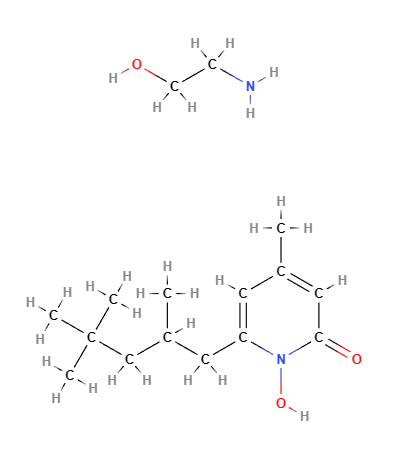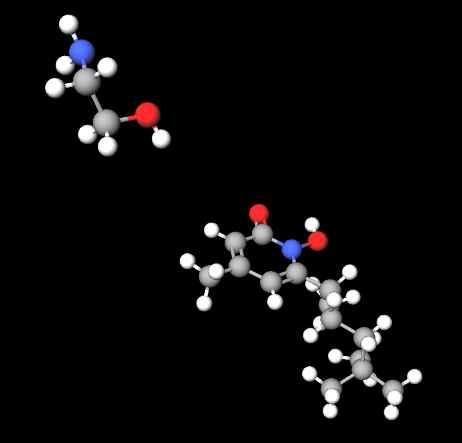![]() Piroctone Olamine
Piroctone Olamine
Rating : 6
| Evaluation | N. Experts | Evaluation | N. Experts |
|---|---|---|---|
| 1 | 6 | ||
| 2 | 7 | ||
| 3 | 8 | ||
| 4 | 9 | ||
| 5 | 10 |
Pros:
Hair care (1)Cons:
Cosmetics Regulation provisions (1)0 pts from Al222
| Sign up to vote this object, vote his reviews and to contribute to Tiiips.Evaluate | Where is this found? |
| "Descrizione" about Piroctone Olamine by Al222 (20707 pt) | 2024-May-18 18:56 |
| Read the full Tiiip | (Send your comment) |
Piroctone Olamine is a chemical compound used as an antifungal and antimycotic agent in cosmetic formulations, especially in hair care products.
The name describes the structure of the molecule:
- Piroctone indicates the presence of piroctone, an organic compound known for its antifungal properties.
- Olamine indicates that the piroctone is stabilized with olamine, an organic base that enhances the solubility and effectiveness of the compound.
Chemical Industrial Synthesis Process
- Preparation of reagents. The main reagents include amine derivatives, alcohols, and aromatic acids necessary for the synthesis of piroctone olamine.
- Synthesis of intermediate. The synthesis begins with the preparation of an intermediate by reacting an amino alcohol with an aromatic acid in a controlled environment. This intermediate is essential for subsequent synthesis steps.
- Condensation reaction. The intermediate is then subjected to a condensation reaction with another specific chemical compound to form the basic structure of piroctone olamine.
- Cyclization. The basic structure undergoes cyclization to form the characteristic pyridinic core of piroctone olamine.
- Purification. After the cyclization reaction, the crude product is purified using techniques such as crystallization, filtration, and chromatography to remove impurities and byproducts of the reaction.
- Stabilization. Piroctone olamine is stabilized to ensure its stability during transportation and storage, maintaining its efficacy in product formulations.
- Quality control. The purified piroctone olamine undergoes rigorous quality testing to ensure it meets the required standards for purity, efficacy, and safety. These tests include chemical analysis, spectroscopy, and microbiological testing.
What it is used for and where
Piroctone Olamine is valued for its effectiveness in treating dandruff and other scalp conditions associated with pathogenic fungi and yeasts. It inhibits the growth of microorganisms that cause irritation and flaking, making it an ideal active ingredient in anti-dandruff shampoos and scalp treatments. In addition to promoting a healthy scalp, Piroctone Olamine helps to reduce itching and improve the appearance of the hair. It is also used in some skin care products, such as creams and lotions, for its antimicrobial properties.
Medical
Piroctone Olamine is used in creams, lotions, and skin solutions to treat dermatological conditions such as seborrheic dermatitis (1), psoriasis, and tinea versicolor.
Cosmetics
t is a restricted cosmetic ingredient as III/61 and V/35 a Relevant Item in the Annexes of the European Cosmetics Regulation 1223/2009. Substance or ingredient reported:
- Monoalkylamines, monoalkanolamines and their salts. Maximum concentration in ready for use preparation Maximum secondary amine content: 0.5%. Other - Do not use with nitrosating systems - Minimum purity: 99% - Maximum secondary amine content: 0.5% (applies to raw materials) - Maximum nitrosamine content: 50 microgram/kg - Keep in nitrite-free containers.
- 1-Hydroxy-4-methyl-6-(2,4,4-trimethylpentyl)-2 pyridon and its monoethanolamine salt. Product Type, body parts a) Rinse-off products b) Other products. Maximum concentration in ready for use preparation a) 1.0% b) 0.5%
Cosmetics - INCI Functions
Anti-sebum. Controls and reduces emissions from the sebaceous glands, which are responsible for greasy, enlarged pores in the skin, where it occurs, particularly on the forehead, cheeks, nose and hair. Adjuvant in the treatment of acne.
Preservative. Any product containing organic, inorganic compounds, water, needs to be preserved from microbial contamination. Preservatives act against the development of harmful microorganisms and against oxidation of the product.
Cosmetic Applications.
Anti-dandruff treatment. Piroctone Olamine is a key ingredient in many anti-dandruff shampoos (2) because of its ability to fight the fungi that cause dandruff, reducing itching and flaking.
Antimicrobial properties. It helps reduce the presence of bacteria and fungi on the scalp and skin, preventing infection and improving overall skin health (3).
Soothing effects. Soothes irritated scalp, providing relief from itching and irritation.
Versatility . In addition to shampoos, it is used in conditioners, lotions, and skin treatments for its antimicrobial and soothing properties.
Other Applications
Pharmaceutical Products. It is used in creams, lotions, and topical solutions to treat dermatological conditions such as seborrheic dermatitis, psoriasis, and tinea versicolor.
Intimate Hygiene Products. Employed in intimate cleansers for its antibacterial and antifungal properties, ensuring gentle and effective protection.
 |  |
Molecular Formula C16H30N2O3
Molecular Weight 298.42 g/mol
CAS 68890-66-4
UNII A4V5C6R9FB
EC Number 272-574-2
Synonyms:
octopirox
Kopirox
Bibliografia_____________________________________________________________________
(1) Piquero-Casals J, Hexsel D, Mir-Bonafé JF, Rozas-Muñoz E. Topical Non-Pharmacological Treatment for Facial Seborrheic Dermatitis. Dermatol Ther (Heidelb). 2019 Sep;9(3):469-477. doi: 10.1007/s13555-019-00319-0.
Abstract. Facial seborrheic dermatitis (FSD) is a chronic and relapsing inflammatory skin disorder occurring in areas of the face rich in sebaceous glands. It clinically manifests as erythematous scaly macules or plaques, often associated with pruritus. Although the pathogenesis of seborrheic dermatitis is not yet fully understood, Malassezia yeast, hormones, sebum levels, and immune response are known to play important roles. Additional factors including drugs, cold temperatures, and stress may exacerbate the condition. Currently, the available treatments do not cure the disease but relieve symptoms. Various pharmacological treatments are available, including antifungal agents, keratolytics, topical low-potency steroids, and calcineurin inhibitors. All of them provide several benefits, but they also have potential side effects. Seborrheic dermatitis tends to have a chronic, recurrent course. To avoid the long-term use of drugs, topical non-pharmacological products such as cosmetics or medical devices may improve clinical outcomes. Products with antimicrobial and anti-inflammatory ingredients such as zinc, piroctone olamine, dihydroavenanthramide, biosaccharide gum-2, and stearyl glycyrrhetinate may speed FSD recovery and avoid flare-ups. Finally, the use of specific cleansers, moisturizers, and sunscreens formulated as light creams or gel/creams should be strongly recommended to all FSD patients. We provide a brief review of the most used non-pharmacological cleansers, topical gel/creams, and specific sunscreens in the management of FSD.
(2) Lodén M, Wessman C. The antidandruff efficacy of a shampoo containing piroctone olamine and salicylic acid in comparison to that of a zinc pyrithione shampoo. Int J Cosmet Sci. 2000 Aug;22(4):285-9. doi: 10.1046/j.1467-2494.2000.00024.x. PMID: 18503415.
Abstract. Dandruff (pityriasis capitis) is a chronic scalp condition characterized by scaling and sometimes itching and redness. Shampoos containing antifungal agents are used to control the scaling condition. In the present study, two shampoos with different actives are compared in a double-blind, randomised and bilateral study on 19 subjects. One shampoo contained piroctone olamine (0.75%) combined with salicylic acid (2%) and the other contained zinc pyrithione (1%) as active ingredient. The subjects were treated twice weekly with the shampoos for almost 4 weeks. Before each treatment the degree of dandruff was evaluated. Both shampoos were highly effective in reducing the dandruff. The combination of piroctone olamine and salicylic acid appeared to be slightly more effective than zinc pyrithione in reducing the severity and area affected by the scaling.
(3) Zelenkova, H. Final report on the pilot trial to verify the effects of Activated Piroctone Olamine (label 100ml) in the management of psoriasis and seborrhoeic dermatitis in patients aged 15 to 60 years.
Abstract. Actived Piroctone Olamine has a proven antiseptic, antimicrobial, antifungal and keratolytic effect. The effect is selective, only acting on the morbidly altered cells. A randomized, simple controlled trial type - III, with post-registration monitoring and continuous inclusion of male and female patients according to criteria was conducted to verify the efficacy and tolerability of Activated Piroctone Olamine (label 100 ml) applied in the management of psoriasis and seborrheic dermatitis in patients with significant manifestations of the disease in varying areas of the body (scalp, torso, extremities) of varying extent and to assess differences in individual tolerability and the final effect in a group of selected patients. A total of 42 patients were included. There were 4 males and 10 females with seborrhoeic dermatitis, and 9 males and 19 females with psoriasis affecting various areas. The effects and satisfaction with the therapy in the group of patients with seborrhoeic dermatitis was evaluated as excellent in about 71% and very good in about 29%. From the patient's point of view, excellent satisfaction was reported by 57% and satisfaction by 49% of the patients included. No undesired effects were reported. No patient was excluded from the study, and follow-up examinations were performed within the specified timeframes, with a maximum deviation of 3 days. The effects and satisfaction with the therapy in the group of patients with psoriasis was evaluated as excellent in about 54% and very good in 46%. From the patient's point of view, excellent satisfaction was reported by 64% and satisfaction by 32% of the included patients. Only one patient, and in one case the investigator, rated the treatment as insufficient or unsatisfactory for the designated area. No undesired effects were reported. No patient was excluded from the study.
| Sign up to vote this object, vote his reviews and to contribute to Tiiips.EvaluateClose | (0 comments) |
Read other Tiiips about this object in __Italiano (1)
Component type: Chemical Main substances:
Last update: 2024-05-18 12:38:40 | Chemical Risk: |


